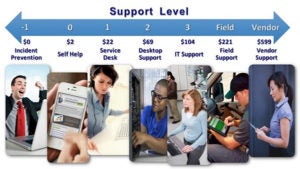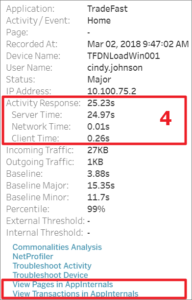Benchmarking First Contact Resolution – Five Ways Aternity Helps You Improve
 As discussed in this series of benchmarking blogs, End User Services teams rely on SteelCentral Aternity because it helps them improve the Key Performance Indicators (KPIs) by which they are evaluated. Previous blogs covered Service Desk cost per ticket and Desktop Support cost per ticket. This one covers End User Services First Contact Resolution (FCR).
As discussed in this series of benchmarking blogs, End User Services teams rely on SteelCentral Aternity because it helps them improve the Key Performance Indicators (KPIs) by which they are evaluated. Previous blogs covered Service Desk cost per ticket and Desktop Support cost per ticket. This one covers End User Services First Contact Resolution (FCR).
The definition of First Contact Resolution
Using MetricNet’s definition, First Contact Resolution is the percentage of contacts that are resolved by the End User Services team on the first interaction with the customer. For end users who reach the team via phone, this means resolving the issue before customers hang up. For chat sessions, it means solving the problem before the chat session ends.
In its benchmarking study of North American contact centers, the SQM Group reports an average First Contact Resolution of 72%. Further, it states that only 5% of call centers in its study meet the world-class FCR standard of 80%. Note that SQM surveys ALL types of contact centers, not just IT teams. This includes non-technical groups handling simpler issues. So the average results for End User Services teams could be quite different because of the complexity of IT issues they handle.
First Contact Resolution drives quality and costs
 Companies measure First Contact Resolution in a variety of ways. Methods include tracking repeat calls, monitoring calls for quality, confirming with customers during a call that their problem is addressed, and surveying customers after a call. But the method of measuring FCR is less important than knowing the impact of FCR on quality and costs.
Companies measure First Contact Resolution in a variety of ways. Methods include tracking repeat calls, monitoring calls for quality, confirming with customers during a call that their problem is addressed, and surveying customers after a call. But the method of measuring FCR is less important than knowing the impact of FCR on quality and costs.
According to SQM, First Contact Resolution is the metric most closely correlated with customer satisfaction. SQM data show a 15% reduction in the highest customer satisfaction ratings (customer satisfaction top box score) for every repeat call a customer has to make to resolve an issue. In addition, every 1% drop in FCR increases operating expenses 1%, reduces overall customer satisfaction ratings 1%, and lowers employee satisfaction between 1-5%.
The impact for IT and the End User Services team is clear. Repeat calls require repeat work, which is frustrating both for end users and contact center staff. Repeat calls negatively affect workforce productivity, for both your End User Services team and your internal customers.
First Contact Resolution is different from First Level Resolution
As Jeff Rumberg explains in a recent article in HDI, First Contact Resolution differs from First Level Resolution (FLR). FLR measures the percentage of tickets the Level 1 Service Desk team resolves on their own, without having to escalate to Desktop Support or other Level 2 or 3 teams. FLR counts the tickets that are resolved at the Service Desk, whether or not a call back was required.
FCR counts the tickets that are resolved on the first contact, whether or not they require an escalation beyond the Service Desk to higher levels of support.
FLR drives ticket costs, since labor rates rise with higher levels of expertise. This table from Jeff’s article shows average total cost per ticket at various levels of support for North American organizations.

Costs per ticket increase with the level of team involved. Note that costs are fully loaded and are cumulative.
Source: Metric of the Month: First Level Resolution Rate, Jeff Rumberg, HDI, November 2017.
You should know two important points about these costs. First, the diagram shows fully loaded costs, including agent salary and benefits, and other overhead costs. Overhead costs include supervisors, facilities, technology, training, and travel. Even more importantly, the costs per ticket are cumulative. So, a ticket resolved at Level 2 costs $91, the total of $69 plus $22, to account for the staff time of both Desktop Support and the Service Desk. Costs really add up when tickets get escalated!
Five ways Aternity helps improve First Contact Resolution
To improve customer satisfaction and operational expense, End User Services teams should resolve tickets on first contact, and at the lowest level possible.
What are some fundamental steps to improve End User Services First Contact Resolution? Start with educating team members on its importance. Then minimize the impact of other KPIs which may conflict with it, such as average ticket handle time. In addition, here are five ways Aternity helps improve FCR.

This dashboard shows what the End User Services team would see when responding to a complaint from an individual end user.
1. Use one product to monitor the end user experience of every app in the portfolio
Unlike with traditional APM products, End User Services teams can use Aternity to monitor end user experience for ANY application. Aternity monitors ALL of the applications your workforce relies on, whether they’re provided by IT or “Shadow IT.” This includes local, web, cloud-delivered, or instrumented mobile apps. Using one product gives your End User Services teams the data they need to investigate user complaints in one call. They don’t need to hand the call off to another team because they lack the tools to monitor a certain type of app.
2. Monitor the end user experience of your workforce on ANY device
Aternity monitors end user experience on laptops, PCs, smartphones, tablets, or virtual devices. So, your End User Services team has the right tool to resolve problems no matter the type of device. Device Performance Monitoring (DPM) products often lack the ability to monitor user experience on mobile devices. Especially in BYOD environments when IT doesn’t own the mobile device.
3. See what users actually see
Some End User Services teams use DPM products to trouble shoot device performance and health issues. DPM products can also see app crashes. Although these products claim they monitor user experience, their visibility isn’t as complete as Aternity’s. The metrics that DPM products monitor do impact end user experience. But they do not monitor exactly what users see when they interact with applications.
With Aternity, your End User Services team can correlate application performance, as seen by the end user, with device health and performance, and the user’s behavior. This enables them to see what users see, the “click to render” time as they interact with applications. Aternity monitors the response time that users see for every monitored business activity. It automatically establishes baselines for normal performance. And it color-codes each activity relative to baseline to alert IT when performance suffers. Because Aternity monitors both current and past interactions, your team doesn’t need to tell the user to call back when the issue occurs again.
4. Drill down from the end user’s device to the application line of code

Aternity shows the contribution to overall response time from the server, network, and client device and provides a 1-click launch to investigate problems in the application
With Aternity, your End User Services team can quickly identify the source of a user’s complaint. Aternity breaks down the overall response time of a business activity to show the contribution by client device, server, and network.
If the problem is in the application, your App Team can take over the issue and launch SteelCentral AppInternals with one click. The seamless hand-off enables your team to resolve the issue in the first call. Watch this short video to see the integration between Aternity and AppInternals in action.
5. End the “network blame game”
Often times, FCR suffers because of the “blame game” between the End User Services team and the Network team. Each team blames the other for the user’s complaint. But the bi-directional integration between Aternity and SteelCentral NetProfiler provides complete insight between these two domains. Your teams can rapidly determine whether an end user issue is due to network congestion, traffic mis-classification, or an under-resourced client device. They can isolate the source of the problem and resolve it on the first contact.
Next Steps
 Your End User Services team may be part of the enterprise IT staff. Or, it may be part of a service offered by an MSP like Blue Ally, or by IT outsourcers, like DXC, Unisys, or Dimension Data. No matter what the case is, Aternity can give you a head start on improving First Contact Resolution. If you’re not yet an Aternity customer, register for instant access to Aternity running in our cloud environment to explore all of its use cases.
Your End User Services team may be part of the enterprise IT staff. Or, it may be part of a service offered by an MSP like Blue Ally, or by IT outsourcers, like DXC, Unisys, or Dimension Data. No matter what the case is, Aternity can give you a head start on improving First Contact Resolution. If you’re not yet an Aternity customer, register for instant access to Aternity running in our cloud environment to explore all of its use cases.
If you are an Aternity customer, and you also use ServiceNow, you can take advantage of the bi-directional integration between Aternity and ServiceNow. Download the Aternity app on the ServiceNow Store. Then contact the Aternity SaaS Admin to configure your Aternity system with the URL of your ServiceNow instance to begin streamlining your operations and improving customer service.
